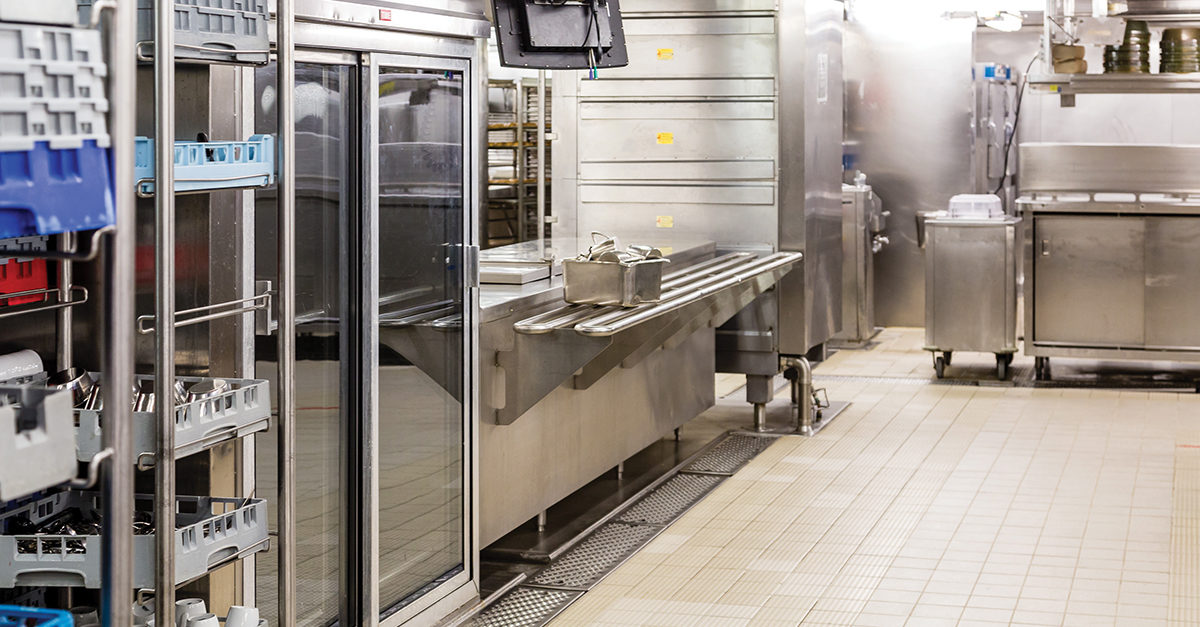According to the U.S. Centers for Disease Control and Prevention (CDC), foodborne illness is a preventable public health challenge that causes 48 million illnesses, 128,000 hospitalizations, and 3,000 deaths annually, sickening one-in-six Americans.
These illnesses largely come from eating contaminated food. In the United States, the bacteria and viruses that cause the most illness include:
- E. coli
- Norovirus (Norwalk Virus)
- Salmonella
- Campylobacter
- Listeria
- Clostridium perfringens.
Since pathogens often survive on kitchen and dining area surfaces, facility cleaning professionals are a key line of defense, and should know the enemy and best weapons to combat it.
Bacteria Lifecycles
Bacteria that tend to make the most people sick can survive on surfaces for a long time. According to the study report, “How long do nosocomial pathogens persist on inanimate surfaces? A systematic review,” survival times on dry surfaces include:
- E. coli: 1.5 hours – 16 months
- Norovirus: 8 hours – 7 days
- Salmonella: 6 hours – 4 weeks
Representative Bugs
E. coli and norovirus, or Norwalk Virus, have frequently been in the news lately—think of articles you may have read about outbreaks in chain restaurants and on cruise lines—so let’s discuss these bugs.
E. coli is a type of bacteria that lives in the intestines of humans and animals. The worst form is E. coli O157:H7, which may be resistant to antibiotics. The O157:H7 strain of the bacteria may cause bloody diarrhea, kidney failure, and even death. E. coli can survive in contaminated food and on contaminated surfaces.
Norovirus is the most common cause of acute gastroenteritis—infection of the stomach and intestines—and is often called stomach flu or viral gastroenteritis. Norovirus spreads easily, can survive on contaminated surfaces, or be spread through touching an infected person. It is most often seen on cruise ships, spreading rapidly due to close quarters.
The Problem with Traditional Approaches
Chemical sanitizers and disinfectants are often the default weapon of choice for destroying dangerous pathogens in restaurants, but these substances are toxic and are considered pesticides by the U.S. Environmental Protection Agency (EPA). They also require the pre-cleaning of surfaces, precise dilution, and dwell time to be effective—steps that are often omitted or mishandled. Additionally, sanitizers and disinfectants can become inactive through contact with food residue, and service staff must be trained in an exacting process to use disinfectants effectively.
Another problem: If used incorrectly, cloths or wipes can spread the very contaminants and microbes they are supposed to remove.
Better, Safer Alternatives
The ultimate goal is to help ensure the cleaning, sanitizing, or disinfection of food preparation and dining areas by using less-toxic, proven, hygienic methods that do not contaminate food or spread germs around.
More Removal, Less Poisoning
In kitchens, removal methods, such as those provided by spray-and-vac equipment, can be effective by using pressure to apply clean solution and wash soils down to the floor, allowing contamination, including pathogens, to be largely removed by vacuuming. A sanitizer or disinfectant can be applied as needed, following label instructions.
Autoclaving Food Service Areas
Applying dry (6 percent moisture) steam-vapor technology to surfaces may equate to autoclaving surfaces, just as medical instruments are disinfected or autoclaved using saturated steam in health care environments.
Applying saturated steam vapor has several advantages. It only uses tap water and does not use conventional chemicals to produce hot, low-moisture, penetrating steam for killing E. coli and norovirus. This prevents exposure to hazardous and toxic chemicals, and particularly for the food service industry, it can dissolve grease and oils for removal without harsh solvents.
Wiping not Spreading
Microfiber towels are the preferred wipes in food service environments, as they remove more soil than cotton towels. However, color coding these for use in particular areas is very important, as is proper folding to expose a fresh surface for wiping to avoid cross-contamination.
Color-coded microfiber towels are available with numbers on each panel to enable systematic wiping for more hygienic results. The towels have numbered quadrants (1–4 on one side, and 5–8 on the other) creating eight fresh sections for optimized wiping to remove more soil (without redepositing it) than a wad-and-wipe method. When a section becomes soiled, users can flip the towel to a fresh side in succession until reaching the eighth side. After that, the towel needs to be washed and rinsed or replaced.
Keeping Facility Occupants Healthy
At the end of the day, the goal is to provide a hygienic environment for both diners and cleaning staff who must deal with the cleaning equipment and products. Following these practices can help you to achieve this in your food service facility.


